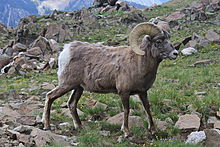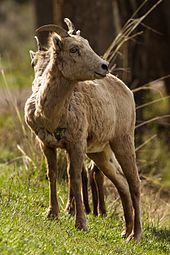Bighorn sheep are named for the large, curved horns borne by the rams (males). Ewes (females) also have horns, but they are shorter with less curvature. They range in color from light brown to grayish or dark, chocolate brown, with a white rump and lining on the backs of all four legs. Males typically weigh 128–315 lb, are 35–41 in tall at the shoulder, and 63–73 in long from the nose to the tail. Females are typically 75–201 lb, 30–35 in tall, and 50–62 in long. Male bighorn sheep have large horn cores, enlarged cornual and frontal sinuses, and internal bony septa. These adaptations serve to protect the brain by absorbing the impact of clashes. Bighorn sheep have preorbital glands on the anterior corner of each eye, inguinal glands in the groin, and pedal glands on each foot. Secretions from these glands may support dominance behaviors.

Bighorns from the Rocky Mountains are relatively large, with males that occasionally exceed 500 lb and females that exceed 200 lb. In contrast, Sierra Nevada bighorn males weigh up to only 198 lb and females to 132 lb. Males’ horns can weigh up to 30 lb, as much as all the bones in the male’s body.

At their peak, North American bighorn sheep numbers were estimated at 2 million. Desert populations have since fallen to about 20,000 and Rocky Mountain populations are at about 45,000. Arizona’s bighorn population, consisting of both desert and Rocky Mountain races, is estimated at 6,000 animals. The causes for this decline, which occurred primarily between 1850 and 1900, were competition with livestock for food and water and exposure to livestock associated parasites and diseases.

